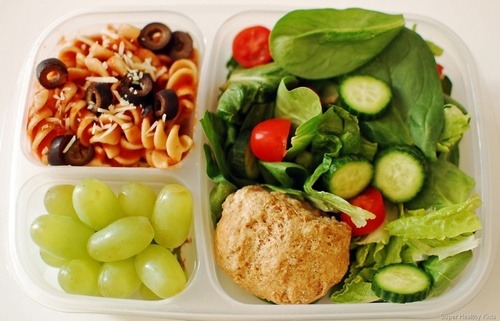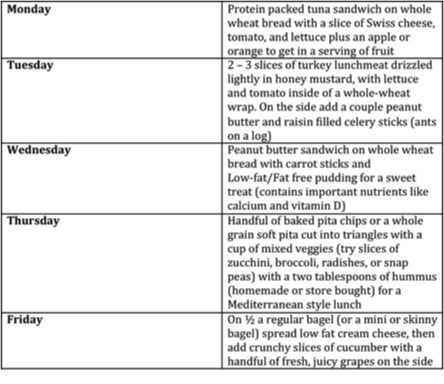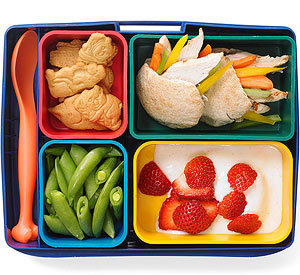Sage is here to help.
Feel like you could be eating better? Not sure what to change or where to look? Sage Nutritious Solutions make it easy for you to discover the wide, wonderful world of balanced, healthy, bangin' food.
Packing Healthy School Lunches 101
The school year is now well underway - one big challenge you may be faced with is packing for your child's school lunch. Packing a healthy and nutritious lunch that your child will actually eat and not ditch for vending machine chips or corner store candy can be difficult. Eating a healthy meal at lunch will not only help your kid retain his or her energy for the second half of the school day, but it will also provide them with long term health benefits as well. Here are 6 tips to help you nail healthy school lunches and a 5-day sample menu of delicious ideas to pack!
Get your child involved. Your child is much more likely to eat a packed lunch that they helped to prepare. The younger aged children may require more assistance, but allowing them to help with lunch time choices and prep will encourage independence and set them up for better future eating habits. Ask them if they prefer tuna or turkey, an apple or an orange. Let them spread peanut butter and jelly or collect all the ingredients from the fridge. This is a great opportunity to use dinner leftovers to assemble the next day's lunch - see what your child enjoyed (such as tacos, roasted vegetables, meatloaf, etc.) and toss it in! Involving your child can also be a great bonding opportunity.
Get into a routine. Planning ahead of time is crucial to the success of actually packing a well-balanced lunch versus throwing together something subpar. Schedule time to pack lunch, whether that time is at night or before school in the morning. Establishing a set time to do something everyday will help make sure it actually happens! Also, before you go to the grocery store, write out a list of the items you need in order to avoid buying unnecessary food or too much junk!
Be colorful - which means more fruits and veggies, more nutrients and less boring. If you pack the same tired red apple everyday your child may start dumping it in the trash. Try adding new fruits every other day or at least every week such as bananas, kiwis, mangoes, pineapple, pears, or nectarines. The produce aisle is filled with all kinds of fruits. Take your kid to the grocery store with you and suggest they pick a new fruit to try each time! This same rule can apply to vegetables. Carrot and celery sticks are common favorites with children but broccoli florets, slices of zucchini, and cherry tomatoes can also make great side dishes that taste wonderful too. Pair most veggies with low-fat ranch dressing or hummus dip for an easy side dish or snack to hit that goal of 3-5 servings per day.
Include whole grains, calcium rich foods (dairy and non dairy options), protein, fruits, and vegetables. Aim to incorporate at least 3 of these 5 food groups with every lunch. For a lot of kids, the flavor and texture of whole grain breads turns them off… therefore, white bread may be more palatable for children, however you can easily find softer whole wheat breads that are made with well ground flour. Choosing whole grain breads, wraps, and crackers for lunches is a great way to get more nutrients and fiber in your child's diet. Dairy foods like pudding, milk, and yogurt are excellent sources of calcium, which is a very important nutrient during the bone building years of adolescents. Eating dairy is not as important as getting adequate calcium - if your child is lactose intolerant or you have other reasons for dairy restriction, make sure your child eats other foods that are rich in calcium. Dark green leafy vegetables, fortified 100% orange juice, almonds, and legumes are just a few examples of alternative calcium sources. Try to incorporate as many different fruits and vegetables as possible while encouraging your child to try new foods to ensure they get lots of different vitamins and minerals. Protein is also a very important nutrient because it promotes muscle and tissue growth. Meat is not the only source of protein; other examples include nuts, peanut butter, beans, and tofu.

Drink more water! Staying hydrated throughout the day is very important. Not all beverages are created equally. Soda and sugary juices are a big part of the health problem we face because they don't provide children with the nutrients needed. They also contain a lot of empty calories from added sugar. In addition to water, other healthy drink options may include low fat or fat free milk and juices that are labeled 100% fruit juice (which means they do not contain added sugars, only the sugar that naturally occurs in the fruit).
Don't forget food safety. Always wash your hands with warm water and soap before handing food. In addition, clean countertops where food is prepared, all food utensils, and lunch bags after each use. Check the expiration date on lunchmeat, and other packaged food items before accidentally sending spoiled foods with your child to school. Make sure you wash all fresh produce before using in sandwiches or sticking in snack bags. Use ice packs or plastic water bottles that have been frozen inside lunch boxes to keep foods at appropriate temperatures to reduce the risk of food borne illness.
5 Days of Healthy, Easy, and Scrumptious School Lunches to Pack:
Obesity rates among our children are still at a staggering high. Children are not getting enough of the vitamins, minerals, and other nutrients needed in their diets for optimal health. School lunch programs are changing and attempting to combat this issue, however the best place to ensure healthy eating and building good life long habits starts at home. Packing healthy school lunches is only one component - but still a very important one. If you struggle with a picky eater or planning meals, there are resources that can help. The-Sage.org is constantly putting out new recipes, many of which that are kid friendly. Eatright.org is another great website, through the Academy of Nutrition and Dietetics, that offers a plethora of information, material, and ideas for getting on a path to healthier eating for you and your whole family!

Happy Eating!
Alexandra Wolz, Nutritionist for:
